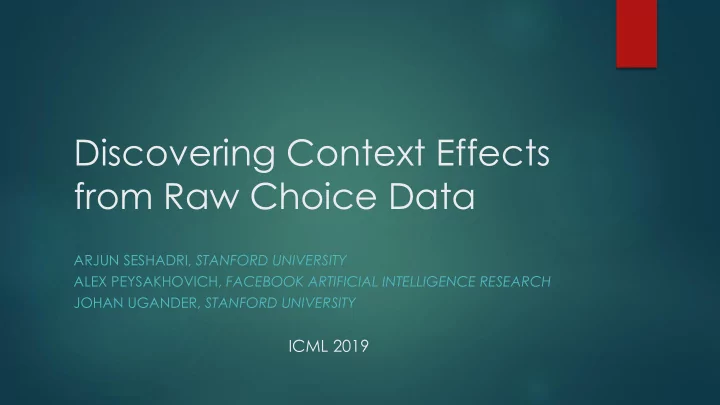

Discovering Context Effects from Raw Choice Data ARJUN SESHADRI, STANFORD UNIVERSITY ALEX PEYSAKHOVICH, FACEBOOK ARTIFICIAL INTELLIGENCE RESEARCH JOHAN UGANDER, STANFORD UNIVERSITY ICML 2019
Modelling in Discrete Choice Data of the form where “alternative is chosen from the set ” and is a subset of , the universe of alternatives Discrete choice settings are ubiquitous
Modelling in Discrete Choice Data of the form where “alternative is chosen from the set ” and is a subset of , the universe of alternatives Discrete choice settings are ubiquitous
Encompasses Many Fields Virtual Assistants Inverse reinforcement learning Structural Modeling Recommender Systems
Independence of Irrelevant Alternatives (IIA) Compromise Effect Fully determines the workhorse Multinomial Logit (MNL) Model Main (strong) assumption: Savings The Good : inferentially tractable, powerful, and interpretable The Bad : Size When IIA does not hold, out of sample predictions are wildly miscalibrated Cannot account for the wide literature on context effects (e.g. Compromise Effect)
Problems we address Modelling individual choice behavior Behavioral economics “anomalies” are all over the place Search Engine Ads (Ieong-Mishra-Sheffet ’12, Yin et al. ’14) Google Web Browsing Choices (Benson-Kumar- Tomkins ’16) Need to model while retaining parametric and inferential efficiency “ad group quality” Statistical tests for violations of IIA General, global tests are intractable (Seshadri & Ugander ‘19, Long & Freese ‘05) Model based approaches challenging due to identifiability issues (Cheng & Long, ‘07)
Context Dependent Utility Model (CDM) Universal logit model (McFadden et al., ’77) Developing the CDM
Context Dependent Utility Model (CDM) Decompose the model (Batsell & Polking , ’85) Universal logit model (McFadden et al., ’77) Developing the CDM
Context Dependent Utility Model (CDM) Decompose the model (Batsell & Polking , ’85) Universal logit model (McFadden et al., ’77) Truncate to 2 nd order (effects are pairwise) Full Rank CDM Developing the CDM
Context Dependent Utility Model (CDM) Decompose the model (Batsell & Polking , ’85) Universal logit model (McFadden et al., ’77) Truncate to 2 nd order (effects are pairwise) Make a low rank approximation (parameters linear in items) Low Rank CDM Full Rank CDM Developing the CDM
Context Dependent Utility Model (CDM) Decompose the model (Batsell & Polking , ’85) Universal logit model (McFadden et al., ’77) Truncate to 2 nd Other items order (effects change how features are are pairwise) Make a low rank traded off approximation (parameters linear in items) Low Rank CDM r-dimensional latent feature Full Rank CDM vector r << n items Developing the CDM
A Theoretical Preview
A Theoretical Preview Identifiability Sufficient: Necessary: More generally:
A Theoretical Preview Identifiability Convergence Guarantees Sufficient: Necessary: More generally:
A Theoretical Preview Identifiability Hypothesis Testing Convergence Guarantees Sufficient: Necessary: More generally:
Unifying Existing Choice Models Low Rank CDM
Unifying Existing Choice Models Tversky-Simonson Model Low Rank CDM (Tversky & Simonson, 1993)
Unifying Existing Choice Models Tversky-Simonson Model Low Rank CDM (Tversky & Simonson, 1993) Batsell-Polking Model (Batsell & Polking, 1985)
Unifying Existing Choice Models Tversky-Simonson Model Low Rank CDM (Tversky & Simonson, 1993) Batsell-Polking Model Blade-Chest Model (Batsell & Polking, 1985) (Chen & Joachims, 2016)
An Empirical Preview: Performance and Interpretability
An Empirical Preview: Performance and Interpretability Transportation Preferences (Koppelman & Bhat, ‘06) Survey of transportation choices for residents in various San Francisco neighborhoods Low Rank CDMs significantly outperform MNL and MMNL
An Empirical Preview: Performance and Interpretability Not Like the Other (Heikinheimo & Ukkonen , ‘13) Individuals are shown triplets of nature photographs asked to choose photo most unlike the other two CDM illustrates intuitive property of dataset: similar items have negative target-context inner product Induces grouping by similarity in both target and context vectors Transportation Preferences (Koppelman & Bhat, ‘06) Survey of transportation choices for residents in various San Francisco neighborhoods Low Rank CDMs significantly outperform MNL and MMNL
Conclusions CDM models context effects with efficiency guarantees and enables practical tests of IIA Can be easily applied to many pipelines by modifying “the final layer” Simultaneously brings both: Machine Learning rigor to Econometrics models (identifiability, convergence) Econometrics modeling (choice set effects) into Machine Learning research Thanks!! Discovering Context Effects from Raw Choice Data Arjun Seshadri, Alex Peysakhovich, and Johan Ugander Poster: Pacific Ballroom #234
Recommend
More recommend